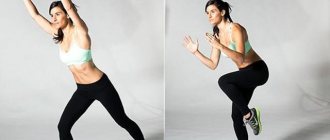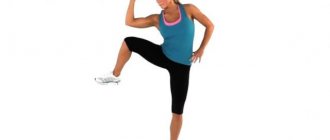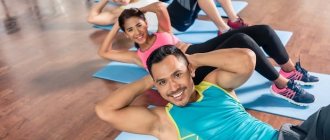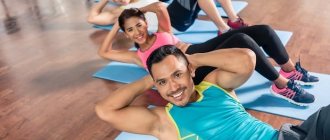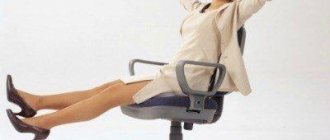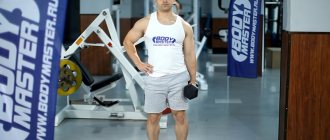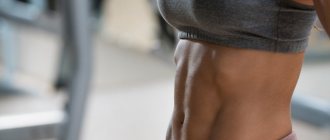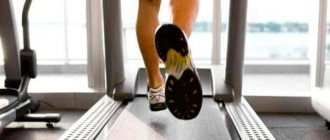Welcome to our blog! Today we will talk about how boxers pump up their abs. The abs and muscles in general represent a protective layer. The harder it is, the more difficult it is to break through. But it should be noted that it is still not so difficult to disable an enemy even with a strong press. To do this you need to get into the liver. So remember, dear friends, the right elbow should always cover this part of the body. The left shoulder protrudes forward and is raised - this is how the jaw is covered, another extremely important part of the body that must always be covered. Otherwise, a knockout cannot be avoided. A strong abs in boxing can withstand a blow to the solar plexus. Thus, the athlete’s breathing is not interrupted and he can successfully continue the fight.
What other functions do the abdominal muscles perform? Press for a fighter is, first of all, posture. Pumped muscles support the spine, protect and support the internal organs of the abdominal cavity.
It should be noted that endurance indicators increase significantly. The abdominal muscles allow you to keep your back in a vertical position. This is especially true on slopes, as well as heavy missed shots. The back is not subjected to excessive stress.
The structure of the abdominal muscles
The abdominal muscles are responsible for human posture, help support the spine, protect and support the organs that are located in the abdominal cavity, and form the abdominal wall. The so-called abs are made up of four muscle groups: the rectus abdominis, transverse abdominis, external oblique and internal oblique muscles. Therefore, to the question of novice athletes “how to load the abdominal muscles correctly in order to get a beautiful abs,” it is more correct to answer: “only with a set of exercises,” loading each abdominal muscle separately and in combination with other muscles.
Video about the structure of the abdominal muscles
Rectus muscle
Location
Located on the front surface of the abdomen. The rectus muscle is crossed transversely by muscle fibers, thus forming the notorious “cubes” of the abdominal press.
Function
Responsible for pulling the ribs down, bending the torso forward and raising the pelvis with a fixed chest, and for moving the lower back and pelvis.
How to strengthen the rectus muscle?
Raising the torso and legs from a supine and sitting position, with a stationary chest (in several options, including on an inclined board), twisting, bending the torso while lying on the floor, lifting the torso in a supine position with a stationary pelvis
Transversus muscle
Location
It is located inside the abdominal muscle corset (its muscle bundles lie horizontally and encircle the waist).
Function
Tightens the stomach, supports internal organs. When the transverse muscle weakens, it holds the organs worse and a saggy or protruding belly is created, which spoils the figure in our minds.
How to strengthen the transverse muscle?
Leg raises in various variations (bent or straight).
External oblique muscle
Location
Located on the side of the rectus muscle.
Function
Responsible for bending the torso, for turning the torso in the other direction (the left oblique is responsible for turning to the right, the right oblique is responsible for turning to the left), for raising the pelvis with a fixed chest, and pulls the ribs down.
How to strengthen the external oblique muscle?
Turns, rotation of the body, including lying on your back, “bicycle”.
Internal oblique muscle
Location
Located under the external oblique muscle.
Function
Participates in flexing the torso and raising the pelvis with the chest fixed, turning the torso in the direction on which the muscle itself is located.
How to strengthen the internal oblique muscle?
Rotation of the torso, raising the knees in turn to the right and left shoulders while hanging on the bar; lifting the body with rotation, bending to the sides.
In general, to get toned abdominal muscles, it is better to do exercises with many repetitions, since the abdominal muscles belong to the endurance category. You can distinguish between exercises that work one specific muscle and combined exercises that work several muscles at once.
Why pump up your abdominal muscles?
A flat and toned stomach is the dream of every healthy person (since when a person is sick, he has no time to look at the profile of his body in the mirror). We want to look slim, fit, with squared shoulders and generally give the impression of a person happy with life. Therefore, the first reason we pump up our abdominal muscles is to become slim and tighten our abdominal muscles. Moreover, pumping up the abs in order to remove the belly is a pressing issue not only for girls and women, but also for the male part of the population. Actually, how to pump up abs for girls is exactly the same as for men, because the abdominal muscles are structured the same in all people. But the appearance of the abs, whether “packs” will appear on it and how soon the abs will get into good shape depends on many conditions (in addition to sports activities), but, above all, on genetics, on physical condition, on the percentage of fat deposits in the area abdomen and from proper nutrition.- In addition, to get a flat stomach, we work out the abdominal muscles to constantly keep it in good physical shape. After all, once pumped up abs and proudly demonstrated to friends and colleagues, they tend to go away as soon as you stop supporting them.
- Abdominal pumping is one of the components of a complete training for any athlete, regardless of his specialization.
- Another of the most pressing questions for women at the beginning of pregnancy is “is it possible and how to pump up the abs during pregnancy.” And, a little later, women begin to worry about how to return to their previous shape, to help the belly “go away faster” after the birth of a child, i.e. When can you start doing abs and other sports exercises after cesarean and after natural childbirth?
What makes your waist small?
Whether you have a thin waist or not is largely determined by heredity and body type. “The easiest way to get a pronounced waist is for girls with an asthenic body type: they are distinguished by thin bones, long limbs, a narrow chest, and muscles that are not prone to hypertrophy,” explains Yulia Malenchuk.
But for hypersthenics it can be very difficult to make a thin waist.
The task becomes more complicated for those who have a small distance between the ribs and the pelvic bone: alas, there will never be a wasp waist here.
The girth of the midsection is also affected by hormonal levels: a large amount of female sex hormones (in particular estradiol) in the blood makes the figure more feminine and the waist thin. And their lack often leads to the opposite effect.
“Waist circumference depends on physiological characteristics, body type, the amount of fat in the abdominal area, nutrition, lifestyle, and hormonal levels. The experience of motherhood may affect you for some time, but it’s quite possible to get back into shape after the birth of your baby,” comments Diana Ibragimova , trainer of the Fitness Territory network of clubs and author of the Instagram blog @di.fitt.
A protruding belly can also “expand” your waist. “Owners of any body type, even very thin girls, can face this problem,” explains Yulia Malenchuk. — In addition to excess weight, there may be several reasons: increased lordosis in the lumbar spine, weak internal muscles, recent pregnancy and even intestinal problems. If the latter needs to be dealt with at an appointment with a gastroenterologist, then the former can be dealt with with the help of exercises.”
Waist circumference may increase after pregnancy. “Its consequences can be increased lordosis in the lumbar region, stretched linea alba, and weak internal muscles. If there is no diastasis that should be removed surgically, the recipe is the same: work with posture and train the internal muscles,” adds Yulia Malenchuk.
How to download press video correctly
Where and with whom to pump up the press?
People who are far from sports work out their abs at home (they usually start every day, then gradually cool down from the load) with one or several exercises, a certain number of repetitions or increasing them gradually, and look in the mirror with hope.
More advanced people go to the gym: there, a trainer tells them how to properly pump up their abdominal muscles. If you don’t have the time or desire to work out at the gym, you can take a program written by a trainer and pump up your abs at home. However, the fact of the matter is that the trainer monitors the correct execution of the exercises, the dynamics of your training and periodically adjusts the program, supplementing exercises for the abdominal press and other muscle groups so that the body develops harmoniously. There is also an incentive to work out in the gym because other, fitter men and women are jumping, running and swinging nearby - there is something to strive for! And it’s convenient to perform the exercises by watching a video of an experienced athlete or fitness instructor training. Where else can this happen? Is it possible to watch a video on how to pump up your abdominal muscles on the Internet, but where is the guarantee that you will choose the training of a good athlete under the guidance of an experienced trainer? Therefore, the benefits of the gym compared to home workouts are obvious.
Professional athletes are not tormented by the question: “how to properly pump up the abdominal press.” They have a trainer who knows how and how many times to do abs and in what exercises, and is responsible for ensuring that his training program brings results.
Is just training enough?
During exercise, muscles use glucose and fat to contract and obtain energy, but this fat does not come from the fat layer, but from the bloodstream. Therefore, it is important to transfer fat from the abdominal fat layers into the bloodstream. Unfortunately, fat enters the bloodstream from any fat depot, and not from the one we would like. Therefore, when exercising any muscle group, fat is consumed from the entire body.
This means that when you start exercising and loading your abdominal muscles, you need to work on reducing the fat layer on your stomach, and this can be achieved through both exercise and proper, balanced nutrition. Fats and simple carbohydrates should be limited in food, while consuming protein in sufficient quantities.
Workout
In order for belly fat to disappear and abs to appear underneath, it is better to load and work the muscles of the whole body. A good option: strength training, followed by 15 to 30 minutes of cardio. How long do you need to pump up your abs? A set of workouts 2-3 times a week is enough, and cardio work can be done daily.
Abdominal development on different machines
Abdominal exercises can be performed while lying on the floor, but in order to fully and correctly do a set of exercises, it is better to use additional devices.
roman chair
The Roman chair is a special bench for swinging the abs. It helps keep the legs and hips in the correct position for swinging the abs, while keeping the buttocks below the knees. Crunches on this machine help strengthen the upper abs, and if these exercises are performed while keeping your back straight, the muscles of the lower abs will also be pumped up. Crunches with turns on this machine make it possible to strain and strengthen the oblique abdominal muscles.
Fitball
A fitball is an inflatable gymnastic ball; its diameter can be 45–95 cm (selected depending on the height of the person who will exercise on it). The ball is convenient for performing abdominal exercises using push-ups, crunches and side crunches.
Incline Ab Bench
The inclined board is fixed with one part to the crossbar of the wall bars, and the other part rests on the floor. Another version of the plank is a machine similar to a Roman chair, but the upper body is slightly elevated on it. On such a machine it is good to do body lifts, which work the muscles of the middle and upper abs.
The whole truth about how to reduce your waist
The waist is one of the most problematic areas of the body for girls, where fat accumulates very easily and an increase in volume occurs. At the same time, the waist and sides area is one of those very areas of the body that is very difficult to correct and which cannot simply be “pumped up” with numerous exercises. Moreover, there is an opinion that it is better not to exercise at all and avoid strength exercises, so as not to make your waist “square”.
As weight increases, the waist is often one of the first to begin to “float”; the sides and so-called “ears” appear. Of course, there are girls who maintain their waist even when they gain weight. Usually these are the owners of a “pear” and “hourglass” figure (or magical Photoshop):
But most often, with an increase in the percentage of body fat, the waist greatly increases in volume, and beautiful curves disappear:
Therefore, the first rule for those who want to get a narrow waist is to reduce the overall percentage of body fat. How to do it? Very simple. Start eating a balanced diet, reduce the amount of fast carbohydrates and fast food, increase activity and physical activity. In other words, force the body to burn fat rather than store it.
But how can you make your body begin to lose weight specifically in the waist area? It is very difficult to burn fat reserves in a certain “problem” area. Whatever exercises you do, prepare for your entire body to lose weight. Fat will melt gradually in all parts of your body, somewhere slower, somewhere faster. It is almost impossible to force the body to reduce specifically the waist area.
So, how to reduce your waist and remove your sides:
- Eat in a calorie deficit and stick to proper nutrition so that the body begins to break down fat.
- Perform cardio exercises to speed up fat burning.
- Perform core (muscle corset) exercises to tighten your muscles and sculpt beautiful body lines.
But for most people, this approach to waist reduction may seem too commonplace. Moreover, when the Internet is replete with such convenient advice as: “a magic corset for the waist - just wear it and lose weight”, “a special diet for the waist for 10 days”, “twist the hoop for 5 minutes a day, and in a week you will reduce your waist by 10 cm". But we will immediately say that there are no magical methods or magical exercises for the waist. Most of the quick methods that are offered on the Internet are absolutely useless in the matter of reducing the waist and eliminating the sides.
What methods will NOT help in reducing your waist:
1. Wraps and massages. They will not help you reduce your waistline. This is a useless event that does not affect the fat burning process, so you should not waste time on it. It's better to spend 30 minutes walking or walking at home if you want to speed up the fat burning process.
2. Hoop. Contrary to popular belief, a hoop is not particularly effective if you want to trim your sides and slim your waist. Of course, twirling a hula hoop is better than doing nothing and lying on the couch. But if you have a little time for sports, then it is better to get in a quality cardio workout than to twirl a hula hoop.
3. Corsets and waist belts. Another useless thing that not only will not help you reduce your waistline, but will also be harmful to your health. Corsets and belts restrict breathing, reduce blood flow to the heart, put pressure on the intestines and impair digestion. At the same time, you will not reduce your waist with the help of a corset; you will only visually hide imperfections in clothes.
4. Special diets to reduce your waistline. There are no special diets or magic foods or drinks to reduce your waistline. If you read about some unique combination of products that will help you reduce your waistline, then remember, this is not true.
5. Wrapping with films and thermal belts during training. This is another unhealthy thing and absolutely useless activity for those who want to reduce their waistline. You won't lose weight, but you may well get dehydrated and seriously strain your heart.
6. Special exercises for the waist. There are no such exercises for the waist. There are exercises that help work the oblique abdominal muscles and strengthen the muscle corset. And there are cardio exercises that help speed up fat burning. Together they can give the desired result. But it doesn’t work in such a way that you do conditional bending and twisting for a week and thereby reduce your waist.
Although we can still recommend one easy way to visually reduce your waist. This is shapewear. It won't reduce body fat or waist size, but it will still help hide imperfections when you're wearing clothes. True, this method will not work on the beach.
Why can't I reduce my waist?
But even proper nutrition and regular exercise may not help reduce your waistline. Why is this happening? Let's look at all the possible reasons why you can't reduce your waist.
1. Your body type is rectangle . With this type of figure, there is either no waist at all, or it is barely pronounced. Body type is determined by genetic factors, and this is almost impossible to change. The most pronounced waist is found in “hourglass” and “pear” shapes. The “apple” and the “reverse triangle” were less fortunate.
2. You do not follow a diet . Even regular workouts will not help you use up your subcutaneous fat reserves. The process of fat burning occurs only with a calorie deficit, when you eat less than the body can process into energy. All unspent calories are stored in fat, which hides your waist.
3. You have rectus diastasis , which often happens after childbirth. As a result, the waist area may “float” a little. For diastasis, it is useful to practice the vacuum exercise, which helps eliminate muscle discrepancy.
4. The reason may be the peculiarity of the shape of the chest , which makes the waist a little voluminous. Regular exercise and proper nutrition will improve your body composition, but it doesn't mean you'll end up with a thin waist.
5. You pay a lot of attention to the oblique abdominal muscles . In general, planks, crunches, bends, and twists without weights will not have a negative impact on your waist and will not increase muscle size (unless you do these exercises for an hour every day, of course). But bending and turning with dumbbells, barbells, and weights can tone your muscles and add volume to your waist.
6. You do strength training with heavy weights. Even if you don't do exercises specifically for the obliques, they are involved in many strength exercises for the arms, back, legs, and buttocks. Regular strength training makes your body fit and toned, but your waistline may suffer.
Each person has their own special unique shape. And there are no people who are 100% satisfied with their body. If you don’t have a naturally narrow waist, that’s okay. To improve contours and achieve a feminine hourglass shape, you can work on the muscles of your shoulders, hips and buttocks. This will help improve your overall body composition.
Exercises on how to pump up your abs
It makes sense to do 20 or more repetitions of abdominal exercises in one approach. And if you need to increase the volume of these muscles, then you should pick up weights (for example, dumbbells), and the number of repetitions can be reduced. It is better to do the exercises by slightly rounding your lower back. Then unnecessary pressure is not created on the lumbar spine, since these exercises involve simultaneous compression and displacement of the joints).
Inclined board press
We hold the crossbar of the wall bars with our hands behind our heads and raise our straight legs up at an angle to the stomach of less than 80 degrees. In this case, the rectus and external oblique abdominal muscles work.- The toes of the feet are fixed to the bolsters on the bench and are located above the head. The torso is at a right angle to the legs bent at the knees, raised from the board. Hands behind your head. Sitting is done on the buttocks. Twist forward, elbows touching knees. The more the board is tilted, the more difficult it is to perform the exercise and the higher the load on the muscles.
- Sitting on a horizontal bench, knees bent at right angles. We hold the edge of the board with our hands on both sides of the body. Raise your knees to your chest.
- The legs lie on a horizontal board across it at a right angle. The torso is on the floor, hands behind the head, head slightly raised. Twisting the torso forward.
- The toes of the feet are fixed to the bolsters on the bench and are located above the head. The torso is at a right angle to the legs bent at the knees, the head is slightly raised from the board. Hands behind your head. Twisting forward, touching the legs with the elbows from the outside of the knees.
- Exercise option 5: Arms extended forward. When twisting, we touch the rollers that hold the legs with straight hands.
How to pump up your abs on a Roman chair?
- Sitting on the machine, hands behind your head. We turn the torso alternately in one direction and the other (in this case, the oblique muscles are worked out).
- Sitting with your arms crossed over your chest, lean back so that your torso is parallel to the floor. Lifting the body (works the top of the rectus muscles).
- The same, turning in different directions.
- The same with weights.
Raising the torso
In this case, the upper rectus abdominis muscles are most involved.
- Lying on your back, feet fixed, knees slightly bent so as not to injure your lower back. Hands behind your head. Slowly raise your torso, piece by piece, as if folding it, to a vertical position and round your back, slightly tilting your shoulders forward.
- The same, but on an inclined bench with your feet higher than your head.
- The same with weights behind the head.
- The same, turning the torso in different directions (we pump up the oblique muscles).
How to pump up your abs: Leg raises
The lower third of the rectus muscles works.
- Lying on your back, hands hold onto something behind your head. We bend our legs at the knees. Slowly raise your legs until they are above your pelvis. Then lift the pelvis off the floor until the lower abdomen contracts as much as possible.
- On an incline bench, raise the edge where your head lies (a higher inclination puts more stress on the abs).
Crunches
The upper rectus muscles work.
- Place your shins on the bench, your torso on the floor, your hands behind your head. We twist, raising our torso and touching our knees with our heads. At the same time, exhale strongly, stay at this point for 2 seconds and return to the starting position.
- Keep your legs suspended without a bench.
- Place your feet against the wall.
- Raise your legs straight and press them against the wall, buttocks against the wall.
- The same exercise options, but with torso rotations (the oblique muscles are involved).
How to pump up your abdominal muscles: Hanging leg raises
This exercise helps answer the question: “ how to pump up your lower abs .”
- Hang on the bar, bend your knees slightly. Raise your legs to a right angle and higher. Hold your legs, then lift your pelvis, twisting.
- The same, legs bent at the knees. We raise our knees to chest level.
- The same, turning the torso.
- The same, with a weight clamped between your legs (but before doing this, perform 2–3 approaches without weights).
Bow stance
Helps make the stomach and sides flatter, slimmer and firmer.
I.P. - lying on his stomach. As you inhale, grab your feet with your palms and stretch upward, helping yourself with your hands. Try to raise your arms as high as possible. Hold the pose for 10-15 seconds and return to the starting position. Repeat 5 times.
How long can you pump up your abs?
Having set the goal of pumping up good abs, you need to decide: how much per day to pump up the abs and pump up the abs every day or less often? For example, boxer Vladimir Klitschko, pumping up his abs with dynamic loads, does a set of 50 repetitions of crunches, sitting on a fitball and throwing a weighted ball with a partner. In addition, 100 lateral twists in each direction.
The questions “how much should you pump your abs” and “how much should you pump your abs per week” will most correctly be answered by a trainer who has assessed your physical condition, percentage of body fat and drawn up a training program. Usually they pump their abs 2-3 times a week, performing a set of exercises .
Ken Norton training
This black American, a boxing professional, had interesting nicknames that confirmed his achievements: Black Hercules, Jawbreaker, Fighting Footsoldier. The quality of his training reflected the approach of the times of Muhammad Ali, whom he faced repeatedly in the ring.
The boxer had 6 training days a week. Not much is known about the physical exercises themselves, nor about the routine.
Ken Norton is another athlete who starts his day with a morning run at 4:00-5:00, gradually transitioning into stretching, showering and rest.
His breakfast consisted of 9 boiled eggs, 7 pieces of bacon, 8 pieces of toast, a cup of cereal and a couple of glasses of juice or milk. That is, of everything that is advised to children for a healthy diet, only in several times larger quantities. His father taught him this: breakfast is the most important meal of the day.
| Routine | Start time | Duration (min.) |
| Stretching, basic exercises for the whole body | 4:00 | ~ |
| Jogging in the morning, 5-12 km | ~ 5:00 | ~ |
| Rest lying down | ~ 6:00 | 15 |
| Shower | 6:15 | ~ |
| Breakfast | ~ | ~ |
| Walk, 5 km | ~ | ~ |
| Dream | ~ | ~ |
| Classes in the hall | 13:00 | 150 |
| Rest | ~ | ~ |
| Dinner of two steaks, beans, lots of vegetables | 17:30 | ~ |
| Watching TV, recordings of your fights | ||
| Dream | 22:30 | 5.5 hours |
Particularly remarkable is the fact of eating twice a day, just like Muhammad Ali: breakfast, dinner. But, unlike his opponent, Ken Norton loved every exercise in the sport that he had to perform. The list of exercises for this boxer looks like this:
- Warm up – 20 minutes for the whole body;
- Shadowboxing – 3 rounds of 3 minutes, 30 seconds break;
- Sparring – 3 rounds of 9 minutes with 30 seconds of rest with three partners;
- Exercises with a pneumatic bag – 3 sets of 3 minutes;
- Heavy bag – 3 sets of 3 minutes;
- Raising a medicine ball (or other load) from the floor to the maximum height – 3 times for 3 minutes, rest 30 seconds.
Is it possible to pump up your abs while being “in an interesting position”?
When carrying a child, a woman’s body needs the same stress as under normal conditions, but now the body should be treated with care. Therefore, abdominal training during this period will not be the same as training girls’ abs under normal conditions. At this important time, it is not recommended to do exercises to stretch the abdominal muscles or pump the lower abs from a lying position. You can load the abdominal muscles while sitting on a chair: lean back a little and return to the starting position. Another option: raise your legs towards your stomach.
Mastering movement
Movement and footwork in boxing are necessary to protect and avoid enemy attacks. Correct mastery of movement, mastery of the principles of transferring the body and center of gravity, and other aspects allows you not only to defend effectively, but also to occupy an advantageous position to launch an attack. Beginners master a regular step as a method of movement, but more advanced practitioners move on to practicing the jumping shuttle method, which is associated with most movements in boxing. The technique of movement in boxing is carried out according to various styles, based on position, stance, distance and many other factors.
Circuit training
Circuit training in boxing is based on the principle of performing a special exercise program at a certain pace to effectively develop the athlete’s strength and speed. The training takes place cyclically, that is, it goes in a circle between different stations with the necessary equipment and equipment. The program includes both simple basic gymnastic exercises and more complex ones necessary for the development of qualities important for a boxer. Circuit training takes place according to certain principles and in nine stages.
Work on shells
Working on apparatus develops the athlete’s technique, improves footwork, develops striking power, and builds endurance. Such training must be carried out with a trainer and wearing gloves. It is characterized by a rapid change in the tempo of movements and loads, transition from one projectile to another, switching between practiced techniques and techniques.
When is it allowed to pump up the abs after a cesarean section?
When you have the time and desire after the birth of your baby to take care of yourself and, in particular, your abs, you can gradually increase your cardio loads, which will help burn fat deposits. Add abdominal exercises to your workout, which some doctors allow you to start working out already in the first week after giving birth (if everything went well and the woman feels normal). If the birth was a cesarean section, then, as a rule, doctors allow you to pump your abs no earlier than six months after the operation so that the stitches heal.
The effectiveness of training a professional boxer.
Professional boxing is so called because sport is a profession that generates income, provides career growth, and meets the interests of society. These are good reasons to be successful. But a greater role in achieving success is played by a focus on results, which allows you to make exercises effective.
While effective boxing training is an important component, there is a parallel that connects the core elements of a champion training plan. These include:
- Mode. A clear routine starts at 5-6 am, includes 1-2 hours of morning jogging and 3-5 hours in the gym in the afternoon.
- Nutrition. Sports legends eat what they want, adding recommended supplements in the form of shakes and vitamins. And a few weeks before an important round, they change their diet.
- Leisure. Every professional receives psychological relief by doing a distracted favorite activity in the evenings.
- Mandatory exercises. There is a certain standard of exercises with slight deviations for each athlete.
- Additional procedures. This means things like massages and evening walks that are relaxing. Sleep was often mandatory after a morning run.
The modern training regime for professional boxing is complex, but many experts believe that in the past it was much more difficult, and the sport itself was more spectacular. In recent years, the rules of behavior in the ring have become stricter, numerous diets have appeared, athletes and coaches have become more cunning and involve more science and medicine in their work. These include psychology, acupuncture, chemistry for pain relief and stopping bleeding.
All this requires a change in the approach to training and their effectiveness becomes hostage to subjective preferences: watchability, humanity, profitability, even to the point of protests by anti-violence activists.
To study the training program for a boxer, let's pay attention to how Muhammad Ali, Roy Jones, Mike Tyson, Ken Norton were brought up. Yes, you should understand that no one will fully reveal all the secrets, but there is something to rely on.
